Attachment
- 1. OBSERVATION TOOLS This packet of Observation Tools was contributed by First District RESA TSS participants. Some of these tools were developed by Teacher Support Specialists to fit observation of a specific teaching task or dimension as identified in the Georgia GTEP Evaluation Manual. Other tools were developed to accommodate observation of unique classroom situations not addressed in a particular GTEP task or dimension. Tool Page Monitoring Individual Student Behavior 2 Effective Classroom Instruction 4 I.E.P. Annual Review 6 Student Procedures 8 Monitoring Behavior 10 Appropriate Behavior 11 Teacher-Student Verbal Interactions 12 Provides Instruction 14 Building for Transfer 15 Managing Learning Environment 16 Tools developed by Teacher Support Specialists. Contributed by Nelda Bishop, First District RESA.
- 2. TSS Nov. 15, 2001 Observation Tool 1 Monitoring Student Behavior Setting: This instrument would be useful in the classroom during instruction. A studentâs behavior would be observed to determine the degree that he or she demonstrates particular behavior skills that are deemed important for students to be successful in the classroom and in life in general. Rationale: The rationale for using an instrument such as the behavior observation checklist is two-fold. One, it helps the teacher identify deficits (or strengths) in studentâs behavior. This information could then be used to develop a behavior plan for the student to follow in the classroom. Two, the observation tool would provide valuable documentation that could be needed during a parent- teacher conference or when discussing a particular student with another teacher experiencing similar problems. An administrator may also find the information useful if disciplinary issues are involved. Instrument: The instrument is designed to work with one particular student that has been pre-identified as a needed case study. To do observations on multiple students with this instrument, student names could be color-coded and the checkmarks would then have to match the color of the name. This may work well with two or three students but with many more it may be confusing. Ideally, one observation instrument per student would be implemented. Data Analysis: Data would show the degree in which the behavior skills are performed. The teacher would need to decide which areas of deficit to concentrate on and ways to increase proficiency in that area. Some means of positive reinforcement should be used. Tools developed by Teacher Support Specialists. Contributed by Nelda Bishop, First District RESA.
- 3. Behavior Observation Student Name:_______________________________ Date:__________________________ Teacher Name: Cindy Felkins Behavior Skill Never Rarely Most of the Time Always On Time and Prepared 1. Arrives to class on time 2. Brings necessary materials 3. Completes homework Respects Peers 1. Respects othersâ property 2. Listens to peers 3. Responds appropriately to peers 4. Respects othersâ opinions 5. Refrains from abusive language Respects Teacher/Staff 1. Follows directions 2. Listens to Teacher/Staff 3. Accepts Responsibility for actions Demonstrates Appropriate Character Traits 1. Demonstrates positive character traits (i.e. kindness, trustworthy, honesty) 2. Demonstrates productive character traits (i.e. patience, thorough, hardworking) 3. Demonstrates a level of concern for others Demonstrates a Level of Concern for Learning 1. Remains on task 2. Allows others to remain on task Tools developed by Teacher Support Specialists. Contributed by Nelda Bishop, First District RESA.
- 4. Observation Tool 2 Effective Classroom Instruction Instructional Setting: This instrument is designed for use in any classroom K-12. The purpose of the instrument is to collect data that reflects effective classroom instruction. Effective instruction is determined by the following criteria: Teacher Preparation/Instruction Format, Classroom Management, and Physical Environment. Rationale: This instrument is designed to reflect evidence of demonstrated basic teaching practices that are necessary for effective classroom instruction. Instrument: The observer will record evidence of criteria by placing a check in the appropriate column. Notes will be written in the âCommentsâ section following each checklist. These will be helpful for the post-conference discussion. Data Analysis: An analysis of the data will enable the observer and the teacher to determine whether the components of effective instruction were demonstrated during the observation. The teacher can use this information to adjust instructional planning and classroom management techniques. Tools developed by Teacher Support Specialists. Contributed by Nelda Bishop, First District RESA.
- 5. Effective Classroom Instruction Checklist I. Teacher Preparation Yes No N/A A. Lesson plans with objectives identified ___ ___ ___ B. Use of technology ___ ___ ___ C. Materials prepared and appropriate ___ ___ ___ Comments: II. Classroom Management Yes No N/A A. Evidence of discipline plan ___ ___ ___ B. Teacher movement in room ___ ___ ___ C. Positive interaction with students ___ ___ ___ D. Provides enrichment/remediation ___ ___ ___ E. Uses appropriate verbal communication ___ ___ ___ F. Uses appropriate nonverbal communication ___ ___ ___ G. Gives clear directions ___ ___ ___ H. Appropriate time management ___ ___ ___ Comments: III. Physical Environment Yes No N/A A. Clean ___ ___ ___ B. Attractive ___ ___ ___ C. Safe ___ ___ ___ Comments: Observerâs Signature Teacherâs Signature Date Date Tools developed by Teacher Support Specialists. Contributed by Nelda Bishop, First District RESA.
- 6. Observation Tool 3 I. E. P. Annual Review Setting: This instrument is designed for use in I.E.P. Annual Review meetings. The Special Education Service Coordinator will organize and conduct the meeting with the I.E.P. Committee. Rationale: The purpose for observing is to enhance efficiency in procedures and operations of the Annual Review process. Special Education teachers are held accountable for I.E.P. paperwork completed within the State and Federal mandated timelines. Instrument: The observer will record data by checking the yes/comment or the no/comment column. Specific notes may be recorded to discuss at the post conference. Data Analysis: Analysis of the data will help enhance the I.E.P. development and implementation. Strengths and successes as well as problem areas will be implemented. Tools developed by Teacher Support Specialists. Contributed by Nelda Bishop, First District RESA.
- 7. Annual Review Observation Instrument Meeting Date: Special Education Service Coordinator: Competencies Observed Yes/Comment No/Comment Competency Teacher introduced members of the committee. I.E.P. Committee included required members. Teacher stated purpose of meeting. I.E.P. included all components as outlined in Annual Review Checklist. Teacher is able to communicate effectively with parents regarding questions and placement. I.E.P. was completed within specified time line. Secured all required signatures. Reviewed Parental Rights. Mentorâs Signature Menteeâs Signature Tools developed by Teacher Support Specialists. Contributed by Nelda Bishop, First District RESA.
- 8. Observation Tool 4 Classroom Procedures Instructional Setting: The observation instrument is designed for use in all classroom settings. Rationale: In every classroom, it is important for students to be aware of classroom procedures. When students clearly know what is required of them and how to carry out certain necessary tasks, learning time is maximized. This is a critical part of any classroom management policy. Instrument: The observer will place a check in the viewed column when students are viewed following the listed class procedures. If procedures are not viewed, a check will be placed in the not viewed column. Other behaviors can be added to the instrument. The comments column is used for notes during the observation. Data Analysis: In evaluating the data, the teacher will be able to determine how well the students follow the set procedures. The teacher analysis will identify procedures that need to be reviewed and procedures that are mastered. It will also help determine if certain procedures need to be added in the classroom. This provides valuable insight into classroom management. Tools developed by Teacher Support Specialists. Contributed by Nelda Bishop, First District RESA.
- 9. Classroom Management: Student Procedures _____Procedures are posted in the classroom. Students follow the Not procedure Viewed Comments for the following: Viewed 1. Entering the classroom appropriately 2. Giving the teacher attention. 3. Seeking teacher assistance. 4. Sharpening pencils. 5. Throwing trash away. 6. Finishing work early. 7. Turning in work. 8. Class dismissal. 10. Using the restroom. 11. Using resource materials. 12. Making up missed work. Tools developed by Teacher Support Specialists. Contributed by Nelda Bishop, First District RESA.
- 10. Observation Tool 5 Checklist for Monitoring Behavior _____ Establish clear and consistent expectations _____ Provides positive feedback when appropriate Examples: _____ Scans class; observes entire class _____ Moves around room _____ Student desks cleared _____ Students begin work together _____ Students raise hand for help _____ Students remain in desks _____ Divides attention equally among students _____ Provides intervention when necessary Behavior Intervention Student Comments: Tools developed by Teacher Support Specialists. Contributed by Nelda Bishop, First District RESA.
- 11. Observation Tool 6 Appropriate Behavior C - Intervening 2 Date: A. Proximity Control Time: B. Eye Contact Subject: C. Signals/Gestures Grade: D. Stating a Rule E. Calling Student Names F. Hand on Shoulder G. Snap Fingers H. Raise Hand I. Count J. Positive Reinforcement K. Sign Language L. Silence M. Change Seating N. Remove Child O. Other Tools developed by Teacher Support Specialists. Contributed by Nelda Bishop, First District RESA.
- 12. Observation Tool 7 Teacher-Student Interaction Setting: Exchanging verbal comments between teachers and students is an integral part of any lesson. This instrument is designed for use in any classroom where teacher-student interaction occurs. Rationale: Effective communication skills are important to the classroom teacher. The teacher must be able to successfully get across the goals of the lesson when the comments of the students are not always predictable or relevant. Therefore, this tool will show how you can enhance the learning environment and increase positive on-task responses with teacher comments. Instrument: A letter from the code selection will be placed in the appropriate box to show the type of response given by the student to the teacher and vise versa. Data Analysis: In evaluating the data, the teacher will be able to tell which students participated, their type of response, and how she reacted to it. The teacher will be aware of those students who make inappropriate responses and the need for possible rephrasing of questions to these students. Tools developed by Teacher Support Specialists. Contributed by Nelda Bishop, First District RESA.
- 13. Type of Other Type of Type of Comments Exchanged Response Comment Question Not related to (Student) Returned by Question Correct-C Teacher Student Name Open ended â O Off Subj.-O Praise-P N Correct-N Negative-N Other-O Closed â C 1. 2. 3. 4. 5. 6. 7. 8. 9. 10. 11. 12. 13. 14. 15. 16. 17. 18. 19. 20. Tools developed by Teacher Support Specialists. Contributed by Nelda Bishop, First District RESA.
- 14. Observation Tool 8 Provides Instruction: Task I Teacher Date: Subject: Time: A. Instructional Level ! Small Blocks Comments _____intersperses practice _____builds on previous knowledge _____lesson organized B. Content Development ! Teacher focused _____definitions _____models _____demonstrating _____examples ! Student focused _____on fee, off seat _____TIM _____instructional aids C. Building for Transfer ! Initial focus _____clear objective _____overview/outline _____reviewing _____purpose/rational/relevance ! Content emphasis _____critical attributes _____link to life experiences/prior or future learning/through association _____similarities/differences ! Summaries _____beginning _____throughout _____end _____student involvement Tools developed by Teacher Support Specialists. Contributed by Nelda Bishop, First District RESA.
- 15. Observation Tool 9 Building for Transfer Initial Focus States objectives clearly Provides a context for objectives w/various techniques (organizers, examples, review, relevance) Gains attention of students Comments: Content Emphasis and/or Linking Stresses the importance of topic Emphasizes critical attributes that distinguish learning Points out similarities & differences Relates to life experiences Provides techniques to facilitate memorization Comments: Summaries Reemphasizes lesson objectives Involves students in review Summarizes/reviews throughout lesson Summarizes/reviews at end of session Comments: Tools developed by Teacher Support Specialists. Contributed by Nelda Bishop, First District RESA.
- 16. Date: Time: Observation Tool 10 Managing the Learning Environment Pro-Active Reactive 1. Detects inappropriate behavior 1. ( ) classroom monitoring and intervenes. [âĶ.having groups begin seatwork 2. Uses proximity control, eye together] contact, signals, and monitoring 2. Observes the entire class and scans a studentâs name to redirect. frequently 3. Prompts student to ensure that 3. Divides attention among students appropriate behavior begins 4. Establishes and maintains rules and after redirection. procedures 4. Provides feedback only to 5. Provides positive feedback students causing problems. 5. Deals with disruption TEACHER appropriately. (i.e., avoids arguments or power struggles. Comments: P - #Proactive R - #Reactive X - Student off task V - Teacher called on volunteer ? - Student asks question N - Teacher called on non-volunteer â - Appropriate response by instructor Tools developed by Teacher Support Specialists. Contributed by Nelda Bishop, First District RESA.

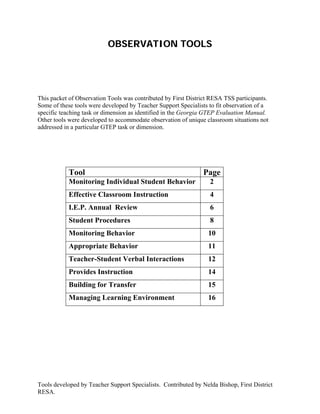
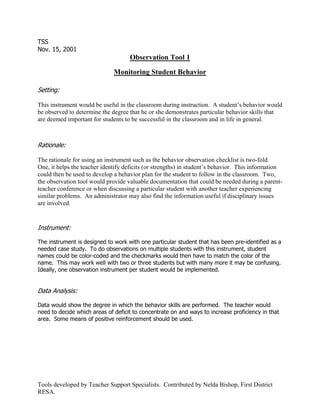


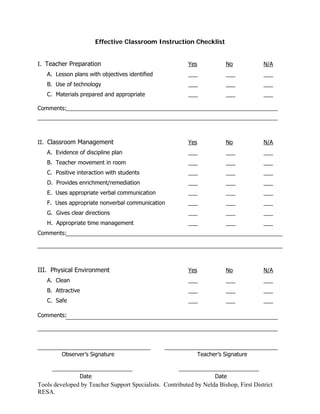
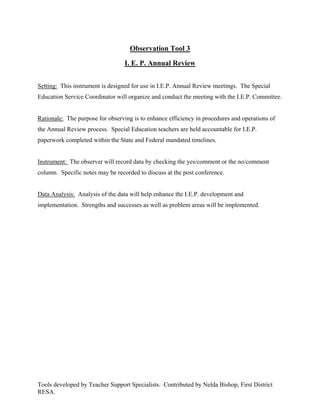
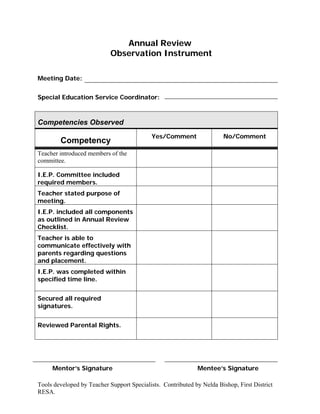
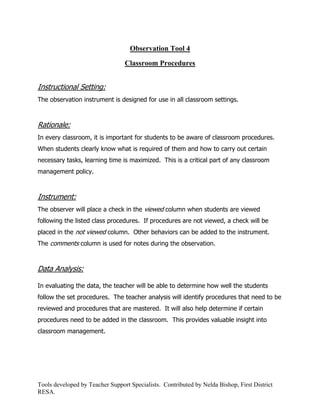

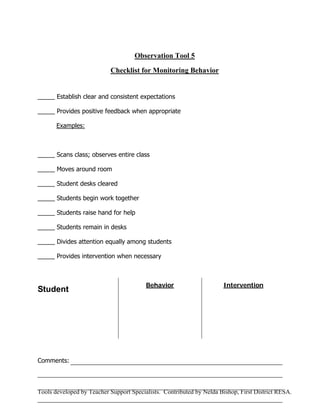
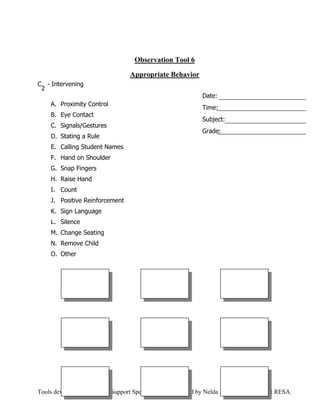

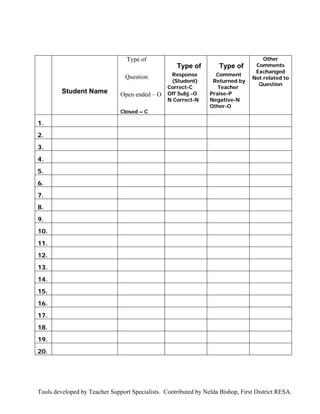
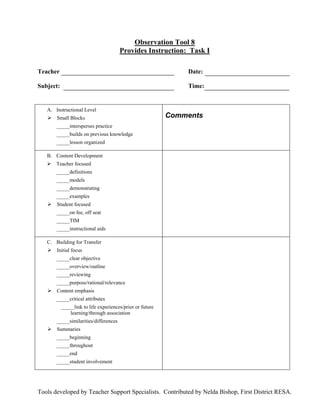

![Date:
Time:
Observation Tool 10
Managing the Learning Environment
Pro-Active Reactive
1. Detects inappropriate behavior
1. ( ) classroom monitoring and intervenes.
[âĶ.having groups begin seatwork 2. Uses proximity control, eye
together] contact, signals, and monitoring
2. Observes the entire class and scans a studentâs name to redirect.
frequently 3. Prompts student to ensure that
3. Divides attention among students appropriate behavior begins
4. Establishes and maintains rules and after redirection.
procedures 4. Provides feedback only to
5. Provides positive feedback students causing problems.
5. Deals with disruption
TEACHER appropriately. (i.e., avoids
arguments or power struggles.
Comments:
P - #Proactive R - #Reactive
X - Student off task V - Teacher called on volunteer
? - Student asks question N - Teacher called on non-volunteer
â - Appropriate response by instructor
Tools developed by Teacher Support Specialists. Contributed by Nelda Bishop, First District RESA.](https://image.slidesharecdn.com/attachment-121204203354-phpapp01/85/Attachment-16-320.jpg)